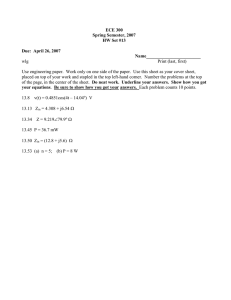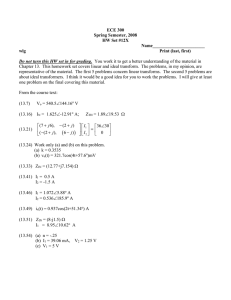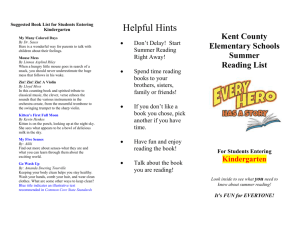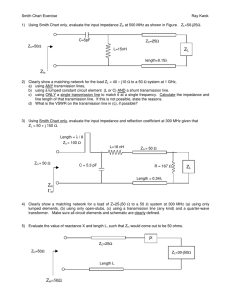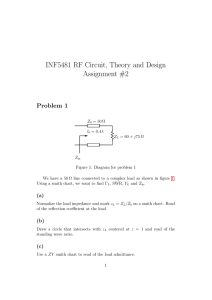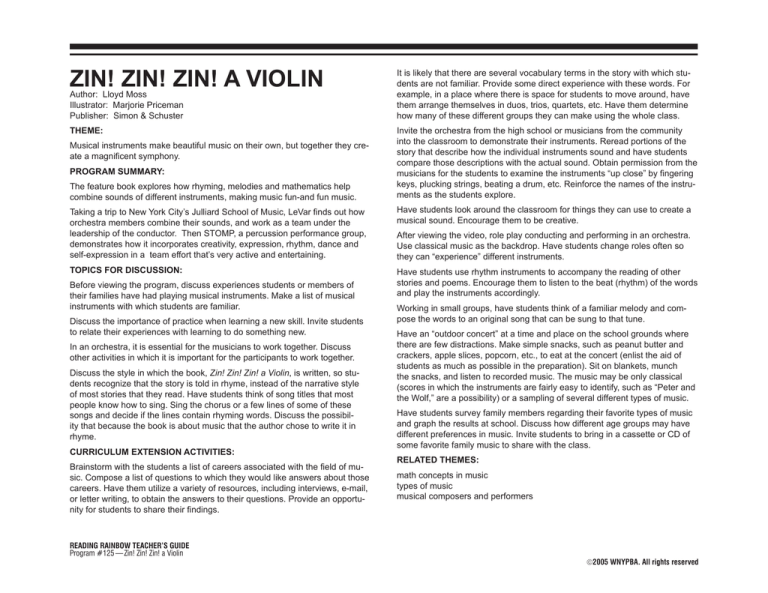
ZIN! ZIN! ZIN! A VIOLIN
It is likely that there are several vocabulary terms in the story with which students are not familiar. Provide some direct experience with these words. For
example, in a place where there is space for students to move around, have
them arrange themselves in duos, trios, quartets, etc. Have them determine
how many of these different groups they can make using the whole class.
THEME:
Invite the orchestra from the high school or musicians from the community
into the classroom to demonstrate their instruments. Reread portions of the
story that describe how the individual instruments sound and have students
compare those descriptions with the actual sound. Obtain permission from the
musicians for the students to examine the instruments “up close” by fingering
keys, plucking strings, beating a drum, etc. Reinforce the names of the instruments as the students explore.
Author: Lloyd Moss
Illustrator: Marjorie Priceman
Publisher: Simon & Schuster
Musical instruments make beautiful music on their own, but together they create a magnificent symphony.
PROGRAM SUMMARY:
The feature book explores how rhyming, melodies and mathematics help
combine sounds of different instruments, making music fun-and fun music.
Taking a trip to New York City’s Julliard School of Music, LeVar finds out how
orchestra members combine their sounds, and work as a team under the
leadership of the conductor. Then STOMP, a percussion performance group,
demonstrates how it incorporates creativity, expression, rhythm, dance and
self-expression in a team effort that’s very active and entertaining.
Have students look around the classroom for things they can use to create a
musical sound. Encourage them to be creative.
TOPICS FOR DISCUSSION:
Have students use rhythm instruments to accompany the reading of other
stories and poems. Encourage them to listen to the beat (rhythm) of the words
and play the instruments accordingly.
Before viewing the program, discuss experiences students or members of
their families have had playing musical instruments. Make a list of musical
instruments with which students are familiar.
Discuss the importance of practice when learning a new skill. Invite students
to relate their experiences with learning to do something new.
In an orchestra, it is essential for the musicians to work together. Discuss
other activities in which it is important for the participants to work together.
Discuss the style in which the book, Zin! Zin! Zin! a Violin, is written, so students recognize that the story is told in rhyme, instead of the narrative style
of most stories that they read. Have students think of song titles that most
people know how to sing. Sing the chorus or a few lines of some of these
songs and decide if the lines contain rhyming words. Discuss the possibility that because the book is about music that the author chose to write it in
rhyme.
CURRICULUM EXTENSION ACTIVITIES:
Brainstorm with the students a list of careers associated with the field of music. Compose a list of questions to which they would like answers about those
careers. Have them utilize a variety of resources, including interviews, e-mail,
or letter writing, to obtain the answers to their questions. Provide an opportunity for students to share their findings.
READING RAINBOW TEACHER’S GUIDE
Program #125 — Zin! Zin! Zin! a Violin
After viewing the video, role play conducting and performing in an orchestra.
Use classical music as the backdrop. Have students change roles often so
they can “experience” different instruments.
Working in small groups, have students think of a familiar melody and compose the words to an original song that can be sung to that tune.
Have an “outdoor concert” at a time and place on the school grounds where
there are few distractions. Make simple snacks, such as peanut butter and
crackers, apple slices, popcorn, etc., to eat at the concert (enlist the aid of
students as much as possible in the preparation). Sit on blankets, munch
the snacks, and listen to recorded music. The music may be only classical
(scores in which the instruments are fairly easy to identify, such as “Peter and
the Wolf,” are a possibility) or a sampling of several different types of music.
Have students survey family members regarding their favorite types of music
and graph the results at school. Discuss how different age groups may have
different preferences in music. Invite students to bring in a cassette or CD of
some favorite family music to share with the class.
RELATED THEMES:
math concepts in music
types of music
musical composers and performers
2005 WNYPBA. All rights reserved
RELATED READING RAINBOW PROGRAMS:
Program #90 — Berlioz The Bear
Program #30 — Mama Don’t Allow
Program #35 — Abiyoyo
Program #51 — Barn Dance!
Program #15 — Ty’s One-Man Band
ABOUT THE AUTHOR:
Lloyd Moss presides over a classical music program at a New York radio station and hosts two syndicated radio shows. He has many TV and film appearances to his credit. Zin! Zin! Zin! a Violin is his first book for children.
ABOUT THE ILLUSTRATOR:
Marjorie Priceman has illustrated several books for children, including the
Reading Rainbow feature book, How to Make an Apple Pie and See the
World. Her whimsical watercolor illustrations earned a Caldecott Honor Book
Award for Zin! Zin! Zin! a Violin. She resides in Lewisburg, Pennsylvania.
BEN’S TRUMPET
by Rachel Isadora (Greenwillow)
MUSICAL INSTRUMENTS
by Gallimard Jeunesse & Claude Delafosse,
illus. by Donald Grant (Scholastic)
A VERY YOUNG MUSICIAN
by Jill Krementz (Simon & Schuster)
THE PHILHARMONIC GETS DRESSED
by Karla Kuskin, illus. by Marc Simont (HarperCollins)
MAKING INSTRUMENTS: 6 INSTRUMENTS YOU CAN CREATE
by Eddie H. Oates, illus. by Michael Koelsch (HarperCollins)
CHARLIE PARKER PLAYED BEBOP
by Chris Raschka (Orchard)
BOOKS REVIEWED BY CHILDREN:
MAX FOUND TWO STICKS
by Brian Pinkney (Simon & Schuster)
MEET THE ORCHESTRA
by Ann Hayes, illus. by Karmen Thompson (Harcourt Brace)
THE MAESTRO PLAYS
by Bill Martin, Jr., illus. by Vladimir Radunsky (Harcourt Brace)
SUPPLEMENTARY BOOKLIST:
MUSIC (“Eyewitness Books”)
by Neil Ardley (Knopf)
MUSIC LESSONS FOR ALEX
by Caroline Arnold, photos by Richard Hewett (Clarion)
THE ORCHESTRA: AN INTRODUCTION TO THE WORLD
OF CLASSICAL MUSIC
by Alan Blackwood (Millbrook)
WILLIE JEROME
by Alice Faye Duncan, illus. by Tyrone Geter (Simon & Schuster)
THE YOUNG PERSON’S GUIDE TO THE ORCHESTRA (with CD)
by Anita Ganeri (Harcourt)
WHAT INSTRUMENT IS THIS?
by Rosmarie Hausherr (Scholastic)
READING RAINBOW TEACHER’S GUIDE
Program #125 — Zin! Zin! Zin! a Violin
2005 WNYPBA. All rights reserved

